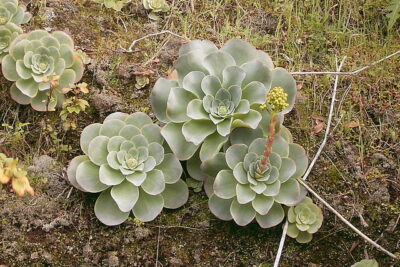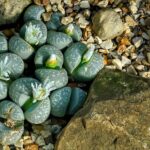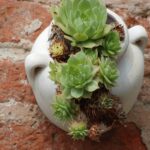
Can Red Rose Succulents Thrive Indoors?

Red rose succulents, also known as "Echeveria" or "Echeveria setosa," are a popular choice for indoor gardening enthusiasts. These stunning plants feature rosette-shaped leaves that resemble the petals of a red rose, hence their name. While succulents are renowned for their ability to thrive in harsh conditions, many people wonder if red rose succulents can be successfully grown indoors.
We will explore the key factors that contribute to the success of red rose succulents as indoor plants. We will discuss the lighting requirements, temperature preferences, watering needs, and soil conditions that are essential for their growth. Additionally, we will provide tips and tricks for caring for these beautiful succulents, including potential challenges and solutions. Whether you're a seasoned indoor gardener or a beginner looking to add some vibrant red hues to your home, this article will guide you on how to cultivate thriving red rose succulents indoors.
- Yes, red rose succulents can thrive indoors
- Provide them with bright indirect sunlight
- Water them sparingly, allowing the soil to dry out completely between waterings
- Use well-draining soil to prevent root rot
- Fertilize them once a month during the growing season
- Prune them to maintain their shape and size
- Watch out for pests such as mealybugs and scale insects
- Keep the indoor temperature between 60-80°F (15-27°C)
- Consider using grow lights if natural light is limited
- Red rose succulents can be grown in containers or hanging baskets indoors
- Frequently Asked Questions
Yes, red rose succulents can thrive indoors
Red rose succulents, also known as Echeveria 'Red Rose', are a popular choice among succulent enthusiasts. While they are typically grown outdoors, these vibrant plants can also thrive indoors under the right conditions.
When it comes to growing red rose succulents indoors, there are a few key factors to consider. First and foremost, it's important to provide them with adequate light. These plants thrive in bright, indirect sunlight, so placing them near a window or providing them with artificial grow lights can help mimic their natural habitat.
In addition to light, proper watering is crucial for the health and growth of red rose succulents. These plants are native to arid regions, so they prefer infrequent watering. It's important to allow the soil to dry out completely between waterings to prevent root rot. Overwatering can be detrimental to the health of the plant, so it's best to err on the side of underwatering rather than overwatering.
When it comes to soil, red rose succulents thrive in well-draining soil that allows excess moisture to escape easily. A mixture of cactus potting soil and perlite or pumice can provide the ideal growing medium for these plants.
 Can Crassula Flapjack Succulent Thrive and Flourish Indoors?
Can Crassula Flapjack Succulent Thrive and Flourish Indoors?As with any indoor plant, temperature and humidity also play a role in the success of red rose succulents. They prefer temperatures between 60°F and 75°F (15°C - 24°C) and moderate humidity levels. Avoid placing them near drafty windows or in areas with extreme temperature fluctuations.
Regular fertilization can also help red rose succulents thrive indoors. Using a balanced, water-soluble fertilizer diluted to half strength once a month during the growing season can provide the necessary nutrients for healthy growth.
Overall, while red rose succulents can thrive indoors, it's important to provide them with the right conditions. Adequate light, proper watering, well-draining soil, suitable temperature and humidity levels, and regular fertilization are all key factors in ensuring the success of these beautiful plants in an indoor setting.
Provide them with bright indirect sunlight
When it comes to indoor succulents, providing the right amount and type of sunlight is essential for their growth and overall health. Red Rose Succulents, also known as Echeveria 'Red Rose', are no exception.
While these vibrant succulents can tolerate some shade, they still require a good amount of bright indirect sunlight to thrive indoors. Placing them near a south or west-facing window is ideal as it allows them to receive the right amount of sunlight without being exposed to direct rays.
It's important to note that direct sunlight can scorch the leaves of Red Rose Succulents, leading to discoloration and damage. Therefore, providing bright indirect sunlight through sheer curtains or by placing them a few feet away from the window is the key to keeping them happy and healthy.
 Can Succulents Thrive Outdoors with Minimal Care?
Can Succulents Thrive Outdoors with Minimal Care?If you don't have access to a well-lit area in your home, you can also consider using artificial grow lights. LED grow lights are specifically designed to provide the right spectrum of light needed for succulent growth and can be a great alternative for indoor gardening.
Remember: Red Rose Succulents may stretch or lean towards the light source if they are not receiving enough sunlight. If you notice this happening, it's a sign that they need more light.
Water them sparingly, allowing the soil to dry out completely between waterings
When it comes to red rose succulents, also known as Echeveria 'Red Rose', many people wonder if they can thrive indoors. These stunning plants with their vibrant red rosettes are a popular choice for outdoor gardens, but they can also be successfully grown indoors under the right conditions.
One of the most important factors to consider when growing red rose succulents indoors is their watering needs. These plants are adapted to survive in arid environments, so it's crucial to water them sparingly. Overwatering can lead to root rot and other issues, so it's best to allow the soil to dry out completely between waterings.
Tips for watering red rose succulents indoors:
- Check the moisture level of the soil before watering. Stick your finger about an inch into the soil, and if it feels dry, it's time to water.
- Use a well-draining potting mix specifically designed for succulents. This will help prevent water from pooling at the bottom of the pot.
- Water the plant thoroughly when you do water, ensuring that water reaches the root zone. Avoid spraying water on the leaves, as this can increase the risk of fungal diseases.
- Consider using the "soak and dry" method. This involves thoroughly soaking the soil and allowing it to dry out completely before watering again. This mimics the natural rainfall patterns in succulents' native habitats.
By following these watering tips, you can help ensure that your red rose succulents thrive indoors. Remember, it's always better to underwater than to overwater, as succulents are more tolerant of drought than excess moisture.
 Indoor Succulent Gardening: Best Tall Succulents for Thriving Indoors
Indoor Succulent Gardening: Best Tall Succulents for Thriving IndoorsUse well-draining soil to prevent root rot
Succulents, including red rose succulents, are known for their ability to withstand dry conditions and thrive in arid environments. However, when it comes to growing red rose succulents indoors, the key lies in providing the right growing conditions to mimic their natural habitat.
One of the most important factors to consider is the type of soil you use. Red rose succulents, like all succulents, require well-draining soil to prevent root rot. This means that regular potting soil is not suitable as it tends to hold too much moisture. Instead, opt for a well-draining succulent or cactus mix which contains a combination of sand, perlite, and peat moss.
By using a well-draining soil mix, you allow excess water to flow freely through the soil, preventing it from sitting around the roots and causing rot. This is especially crucial for indoor plants, as they are more susceptible to overwatering due to the limited airflow and slower evaporation.
When planting your red rose succulent in a pot, make sure to choose a container with drainage holes at the bottom. This will further aid in preventing water from accumulating and causing root rot. As a general rule, it's better to underwater your succulent than to overwater it, so be mindful not to let the soil become too soggy.
Additionally, it's important to note that red rose succulents prefer bright, indirect light. Place your indoor succulent in a location where it can receive at least 6 hours of sunlight every day. If natural light is limited, you can supplement it with a grow light specifically designed for succulents.
To summarize, to ensure your red rose succulent thrives indoors:
- Use a well-draining succulent or cactus mix to prevent root rot.
- Choose a pot with drainage holes to allow excess water to escape.
- Provide bright, indirect light for at least 6 hours daily.
With proper care and attention to their specific needs, red rose succulents can indeed thrive indoors and bring a touch of natural beauty to your indoor space.
 Succulents: Indoor or Outdoor Plants?
Succulents: Indoor or Outdoor Plants?Fertilize them once a month during the growing season
If you want your red rose succulents to thrive indoors, one important aspect to consider is fertilization. Fertilizing your plants once a month during the growing season can provide them with the necessary nutrients to support their growth and overall health.
When choosing a fertilizer for your red rose succulents, it is best to opt for a balanced formula that contains equal amounts of nitrogen, phosphorous, and potassium (NPK). This will ensure that your plants receive a well-rounded nutrient mix.
Before applying the fertilizer, make sure that the soil is moist. This will help prevent any potential damage to the plant's roots. You can use a liquid fertilizer diluted with water or a slow-release granular fertilizer, depending on your preference.
When applying the fertilizer, be careful not to overdo it. Succulents are generally low-maintenance plants and excessive fertilization can lead to nutrient burn or other issues. Follow the instructions on the fertilizer packaging for the appropriate dosage.
Additionally, it is important to remember that fertilization should only be done during the growing season, which typically occurs in spring and summer. During the winter months, succulents enter a dormant phase and do not require fertilization.
By providing your red rose succulents with regular fertilization, you can help promote healthy growth and vibrant blooms. Remember to monitor your plants closely and adjust the fertilization schedule or dosage if needed.
Prune them to maintain their shape and size
 Growing Trunked Succulents Indoors: A Guide
Growing Trunked Succulents Indoors: A GuideWhen it comes to keeping your red rose succulents thriving indoors, one important aspect to consider is pruning. Pruning plays a crucial role in maintaining the shape and size of your succulents, ensuring they stay healthy and visually appealing.
Start by examining your red rose succulents regularly to identify any overgrown or damaged parts. Using a pair of sharp, clean pruning shears, carefully trim away these unwanted sections. It is important to sterilize your pruning tools before and after each use to prevent the spread of diseases.
When pruning, focus on removing any dead, yellowing, or shriveled leaves. This not only enhances the aesthetic appeal of your succulents but also promotes the growth of new, healthy leaves. Additionally, you can also trim the stems to control the overall size and shape of your plants.
Remember, succulents have a natural tendency to grow towards the light source. If you notice your red rose succulents leaning or stretching towards a particular direction, consider rotating them regularly to ensure even growth.
While pruning your red rose succulents, it is important to be cautious and avoid excessive removal of leaves or stems. Over-pruning can weaken the plant and make it more susceptible to diseases and pests. Therefore, always prioritize the health and well-being of your succulents when pruning.
By regularly pruning your red rose succulents, you can help them maintain their shape and size, resulting in beautiful and thriving indoor plants.
Watch out for pests such as mealybugs and scale insects
 Choosing Low-Light Succulents: A Guide to Thriving Indoors
Choosing Low-Light Succulents: A Guide to Thriving IndoorsWhen it comes to growing red rose succulents indoors, one of the challenges you may face is dealing with pests. Mealybugs and scale insects are two common pests that can infest your plants and cause damage if left untreated.
Mealybugs: These small, white, cotton-like insects can quickly multiply and spread throughout your succulent plants. They feed on the sap and can cause stunted growth, yellowing leaves, and even plant death. To get rid of mealybugs, you can try using a cotton swab dipped in rubbing alcohol to gently wipe them off the leaves. Alternatively, you can use a natural insecticidal soap or neem oil spray to control the infestation. It's important to regularly inspect your plants for any signs of mealybugs and take immediate action to prevent their spread.
Scale insects: These pests are small, oval-shaped insects that attach themselves to the stems and leaves of your succulents. They often appear as small bumps or scales and can be green, brown, or black in color. Scale insects also feed on plant sap and can cause similar symptoms as mealybugs. To remove scale insects, you can use a soft brush or cotton swab dipped in soapy water to gently scrub them off the plant's surface. Applying horticultural oil or insecticidal soap can also be effective in controlling the infestation. Regularly monitor your plants for any signs of scale insects and take prompt action to prevent further damage.
Remember, prevention is key when it comes to dealing with pests. Inspect new plants before bringing them indoors and isolate them for a few weeks to ensure they are pest-free. Keep your succulents clean and healthy by regularly dusting their leaves and providing them with proper care, including adequate light, water, and well-draining soil. By taking these precautions and promptly addressing any pest issues, you can help your red rose succulents thrive indoors.
Keep the indoor temperature between 60-80°F (15-27°C)
When it comes to growing red rose succulents indoors, maintaining the right temperature is crucial. These plants thrive best in temperatures between 60-80°F (15-27°C). Anything below or above this range can negatively affect their growth and overall health.
It is important to ensure a consistent temperature within this range throughout the day. Fluctuations in temperature can cause stress to the succulents, leading to wilting or even death. Consider placing the red rose succulents in a room with adequate insulation and temperature control to provide them with a stable environment.
 Growing Aloe Vera Indoors: Tips for Cultivating Succulent Houseplants
Growing Aloe Vera Indoors: Tips for Cultivating Succulent HouseplantsAdditionally, avoid placing the plants near drafty windows or heating/cooling vents, as these can expose them to extreme temperature changes. The goal is to create a comfortable and stable environment for the red rose succulents to thrive.
Consider using grow lights if natural light is limited
When it comes to growing red rose succulents indoors, one of the most important factors to consider is the availability of natural light. While these plants can thrive in bright sunlight, they can also adapt to lower light conditions. However, if you're planning to keep them indoors where natural light is limited, it's highly recommended to consider using grow lights.
Grow lights are artificial light sources that emit a spectrum of light similar to sunlight. They are specifically designed to provide plants with the necessary light wavelengths for photosynthesis. By using grow lights, you can ensure that your red rose succulents receive adequate light to grow and thrive, even in indoor environments.
When choosing grow lights for your succulents, it's important to opt for full-spectrum lights. Full-spectrum lights mimic natural sunlight and provide a wide range of light wavelengths that are essential for plant growth. These lights typically include both blue and red light, which are crucial for photosynthesis and promoting healthy foliage.
Additionally, you should consider the intensity and duration of light exposure. Most red rose succulents require around 12-16 hours of light per day, so it's important to set up a consistent lighting schedule. You can use timers to automate the lighting system and ensure that your plants receive the right amount of light each day.
Positioning your grow lights is also crucial for the well-being of your red rose succulents. Ideally, the lights should be positioned 6-12 inches above the plants to provide sufficient intensity without causing damage. As your succulents grow, you may need to adjust the height of the lights to maintain the optimal distance.
Remember to monitor your red rose succulents closely when using grow lights. Keep an eye on their growth, color, and overall health. If you notice any signs of stress or inadequate lighting, you may need to adjust the positioning, intensity, or duration of the lights.
 Can You Successfully Grow Lotus Lithops Succulents Indoors?
Can You Successfully Grow Lotus Lithops Succulents Indoors?By utilizing grow lights effectively, you can create a suitable indoor environment for your red rose succulents to thrive. With the right amount of light and care, you'll be able to enjoy the beauty of these unique and vibrant plants all year round.
Red rose succulents can be grown in containers or hanging baskets indoors
Red rose succulents, also known as Echeveria 'Red Rose', are a popular choice among succulent enthusiasts. With their stunning rosette-shaped leaves that resemble red roses, these plants can add a touch of elegance to any indoor space.
One of the biggest advantages of growing red rose succulents indoors is that they can be easily grown in containers or hanging baskets. This makes them a versatile option for those who have limited outdoor space or prefer to keep their plants indoors.
When it comes to caring for red rose succulents indoors, there are a few key factors to consider. First and foremost, these plants thrive in well-draining soil, so be sure to choose a potting mix specifically formulated for succulents.
Additionally, red rose succulents prefer bright, indirect light. While they can tolerate some direct sunlight, it's best to place them in a location where they receive bright, filtered light for most of the day. A south-facing window or a spot near a bright, but not scorching, east or west-facing window is ideal.
Proper watering is essential for the health of red rose succulents. As with all succulents, it's important to allow the soil to dry out completely between waterings. Overwatering can lead to root rot and other issues, so err on the side of underwatering rather than overwatering.
 Can You Keep Succulents Indoors Year-Round?
Can You Keep Succulents Indoors Year-Round?During the growing season, typically spring and summer, red rose succulents benefit from a balanced fertilizer diluted to half strength. This can help provide them with the necessary nutrients to support healthy growth.
Benefits of Growing Red Rose Succulents Indoors
There are several benefits to growing red rose succulents indoors. Firstly, they serve as eye-catching decorative elements, adding a splash of color and beauty to your indoor space. Whether you place them on a windowsill, a shelf, or a table, these plants are sure to grab attention.
Furthermore, red rose succulents are relatively low-maintenance plants. They require minimal care and attention compared to other houseplants. Their ability to store water in their leaves allows them to withstand periods of neglect and drought, making them an excellent choice for busy individuals or those new to gardening.
In addition, red rose succulents are known for their air-purifying properties. Like other succulents, they have the ability to remove toxins from the air, improving the overall air quality in your home. This can have a positive impact on your health and well-being.
Overall, red rose succulents can thrive indoors when provided with the right conditions and care. With their stunning appearance and numerous benefits, they are an excellent choice for both experienced gardeners and beginners alike.
Frequently Asked Questions
Can Red Rose Succulents Thrive Indoors?
Yes, red rose succulents can thrive indoors as long as they receive sufficient sunlight and are planted in well-draining soil.
How often should I water my red rose succulent?
Red rose succulents should be watered sparingly, allowing the soil to dry out completely between waterings. Overwatering can lead to root rot.
 Indoor vs Outdoor: Ideal Growing Environments for Succulents
Indoor vs Outdoor: Ideal Growing Environments for SucculentsWhat is the ideal temperature for red rose succulents?
Red rose succulents prefer temperatures between 60°F to 75°F (15°C to 24°C). They can tolerate slightly higher or lower temperatures, but extreme heat or cold should be avoided.
Do red rose succulents require fertilization?
Red rose succulents are low-maintenance plants and typically do not require frequent fertilization. Fertilize once or twice a year with a balanced succulent fertilizer during the growing season.
If you want to read more articles similar to Can Red Rose Succulents Thrive Indoors?, you can visit the Indoor and Outdoor Care category.






You Must Read